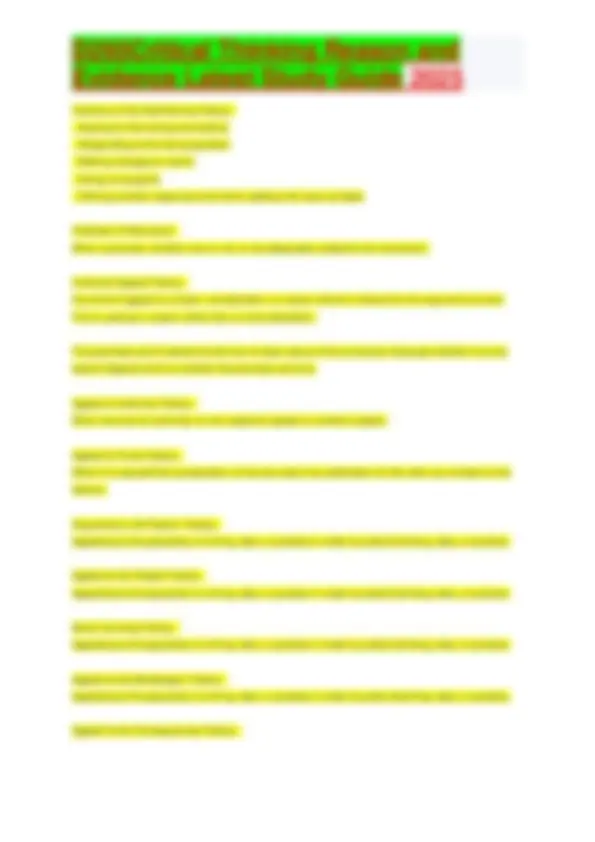










Study with the several resources on Docsity

Earn points by helping other students or get them with a premium plan


Prepare for your exams
Study with the several resources on Docsity

Earn points to download
Earn points by helping other students or get them with a premium plan
Community
Ask the community for help and clear up your study doubts
Discover the best universities in your country according to Docsity users
Free resources
Download our free guides on studying techniques, anxiety management strategies, and thesis advice from Docsity tutors
D265Critical Thinking Reason and Evidence Latest Study
Typology: Exams
1 / 14

This page cannot be seen from the preview
Don't miss anything!









D265Critical Thinking Reason and Evidence Latest Study Guide 2025 Critical Thinking - The ability to think carefully about thinking and reasoning--to criticize your own reasoning. Critical - Reflective, careful, or attentive to potential errors. Critical Thinking - Being curious and thinking creatively; Being billing to go the next step and think about all of the possible positions and arguments before settling into a position. Critical Thinking - Separating the thinking from the position; Removing personal opinion from the discussion and not making it personal against the other person. Critical Thinking - Knowing oneself enough to avoid biases and errors of thought; being thoughtful and aware of personal biases and working against them to challenge thinking. Critical Thinking - Understanding arguments ,reasons, and evidence; thinking carefully about thinking, about arguments, and positions. Propositions - Statements that can be true or false. Non-Proposition Sentences - Sentences that cannot be true or false; cannot disagree with them; cannot argue whether they're right or wrong; cannot question them. Simple Propositions - Proposition with no internal logical structure, meaning whether they are true or false does not depend on whether a part of them are true or false. They simply are true or false on their own. Complex Propositions - Propositions with an internal logical structure, meaning they are composed of simple propositions. Common Anatomy of an Argument -
One or more premises that are propositions that support or demonstrate at least one conclusion. Premise - Propositions/statements that support or demonstrate the conclusion. Conclusion - The point being made and offered for acceptance or rejection as the basis of an argument. Bad Inferential Structure - The argument's premises do not demonstrate or support the conclusion. We can accept the premises as true without being compelled to accept the conclusion. False Premise - The premises in an argument are false. Argument - A set of statements where the premises attempt to provide a reason for thinking that the conclusion is true. Conclusion Indicators - Therefore, Hence, We may conclude that, So, Thus, Implies that, It follows that, Entails that, As a result Premise Indicators - Because, In that, As indicated by, Given that, Since, For, As Inference - Argument Argument - Any purportedly rational movement from evidence or premises to a conclusion. Deductive Inferences - Arguments where the premises guarantee or necessitate the conclusion. Inductive Inferences - Arguments where the premises make the conclusion probable, at best.
Y = true. Therefore, X = true. Denying the Atecedent - Formal fallacy. If X, then Y. X = false. Therefore, Y = false. Modus Ponens - Good deductive structure. Opposite of Affirming the Consequent. If X, then Y. X = true. Therefore, Y = true. Modus Tollens - Good deductive structure. Opposite of Denying the Antecedent. If X, then Y. Y = false. Therefore, X = false. Humiliation Tactics - The goal of the argument is to "win" and even humiliate rather than to connect and understand. The Fallacy Fallacy - When someone uses the fact that a fallacy was committed to justify rejecting the conclusion of the fallacious argument. Red Herring Fallacy - When the arguer changes the subject to something irrelevant to the original topic. Begging the Question Fallacy - When an arguer assumes the truth of the conclusion in one or more of the premises. Content Collapse - Everything on the internet, particularly social media, seems to be taking place in "my context, right now".
Bias - Being predisposed to arrive at a conclusion, even if evidence does not support it. Principle of Charity - Interpreting someone's reasoning or argument in the best possible light. Disarm your Conversant - Letting your opponent know that you understand their position and why someone might believe it. Confirmation Bias - The natural tendency to seek out evidence supporting our beliefs and ignoring the evidence in the way of our beliefs. Confirmation Bias - Ignoring the evidence that undermines what we already believe and putting extra weight on evidence that supports what we already believe. Cognitive Bias - Quirks about the way we naturally categorize and make sense of the world around us. Includes aliefs and mental heuristics (representativeness, availability, and anchor and adjust heuristics) Alief - Automatic belief-type attitudes that can explain how our instinctual responses can conflict with our reasoned-out beliefs. Alief - Automatic or habitual belief-like attitudes--how we instinctively respond. Belief - What you have determined or rationalized consciously. Heuristic - Rule of thumb, a ready strategy, or a shortcut. Satisficing - Satisfy + suffice. Choices that are "good enough" to satisfy our needs. Bounded Rationality -
A form of selection bias. When individuals can opt themselves in to be included in a survey. Selective Reporting - Reporting the same data in different ways to achieve different rhetorical goals. Questions and Who is Taking the Survey - Two things that make or break a survey Non-Response Bias - The people who are most likely to complete a survey are systematically different from those who don't. Voluntary Response Bias - People who choose to respond to voluntary surveys are people who are different from the broader population. Underrepresentation - Random sampling and response bias may accidentally exclude small minority groups. Stratified Random Sampling - Splits the population into groups of interest and randomly selects people from each of the "stratas" so that each group in the overall sample is represented appropriately. Cluster Sampling - Creates clusters that are naturally occurring and randomly select a few clusters to survey, instead of randomly selecting individuals. Snowball Sampling - Used when respondent group is small and/or very specific. When current respondents are asked to help recruit people they know from the population of interest. Census - Surveys an entire population. The US does one every 10 years. Strong Inductive Generalization - A generalization based on an adequate number of relevant cases. Is the generalization based on a sufficient number of germane samples? -
Most relevant question to ask when seeking to identify an unwarranted statistical generalization. How to Counteract: Confirmation Bias - Actively seek out the best justifications for alternative viewpoints and make sure that, when an alternative viewpoint is rejected, it is for good reasons. How to Counteract: Representativeness Heuristic - Look for carefully conducted scientific studies or larger sets of data when available. How to Counteract: Anchoring Bias - Ask, "Is this sample really representative of the population under study?", or, "Do I have enough credible evidence to generalize about this?" System 1 Thinking - Thinking that is quick, automatic, and emotional. System 1 Thinking - Fast Thinking System 2 Thinking - Slow Thinking System 2 Thinking - Thinking that is deliberate, effortful, and calculating. Analysis Paralysis - No decision being made due to weighing too many factors. Narrow Framing - A tendency to see investments without considering the overall portfolio. Mental Accounting - The different values a person places on the same amount of money, based on subjective criteria, often with detrimental results. Numerate - A good basic knowledge of arithmetic; able to understand and work with numbers.
Versions of the Red Herring Fallacy -
Attempts to assume the truth or reasonableness of an idea based on (typically negative) consequences of accepting that idea. Equivocation Fallacy - The same word being used in two different sentences with two different meanings. Ad Hominem Fallacy - When one attacks the person making an argument rather than the argument itself. Genetic Fallacy - When one argues that the origin of an idea is a reason for rejecting or accepting that idea. Straw Figure (Man) Fallacy - When one misrepresents anothe's argument, then attacks the misrepresented (weaker) argument rather than the actual (stronger) argument. Red Herring Fallacy - When one introduces an irrelevant topic. Appeal to Authority Fallacy - When one appeals to an unqualified authority in support of one's claim. Appeal to Force Fallacy - When one uses a threat to compel agreement with one's claim. Appeal to Popularity Fallacy - When one appeals to the popularity of a belief as a reason to affirm its truth. Appeal to Consequences Fallacy - When one appeals to the good or bad consequences of accepting a claim as a reason to accept or reject it as true. Fallacy of Equivocation - When one's argument mistakenly uses the same word in two different senses. Appeal to Ignorance Fallacy - A fallacy that asserts that a proposition is either true or false because it has not been proven either way.
Post Hoc Ergo Propter Hoc Fallacy - When someone claims some other event causes another just because the first event (the alleged cause) occurs before the second event (the alleged effect). Hasty Generalization Fallacy - When someone generalizes too quickly about a group of people, things, or events. Complex Questions Fallacy - The answer to a given question presupposes a prior question. AKA loaded or trick questions. False Dichotomy (Dilemma) Fallacy - A disjunction that does not exhaust all of the possible options. Either/or choices. Burden of Proof Shifting Fallacy - When one decides that someone else must prove them wrong when in reality, they are the person with the burden of proof. FalseDilemma (Dichotomy) Fallacy - When one presumes that there are fewer options (typically two) than there actually are. Begging the Question Fallacy - A circular argument in which a premise of the argument presumes the truth of its conclusion. Burden of Proof Shifting Fallacy - When one presumes that one's (implausible) claim is justified unless someone else demonstrates otherwise. Syllogism - Simple arguments; consist of one or two premises and one conclusion. Independent Premise Support - Each premise seems like an argument for the conclusion on its own. Conjoint Premise Support - The premise does not support the conclusion without the help of other premises. The General-Specific Pattern -
Two premises where one premise is a general definition, generalization, hypothetical/conditional, or general principle, and the other premise is a specific claim about an individual under than generalization. "Level" or "Layer" of an Argument Map - One horizontal row of a carefully drawn argument map. Main Conclusion - The final conclusion of the argument. Always the bottom-most layer in an argument map. Main Premise - One among the set of premises directly supporting the main conclusion. Always the second-to-bottom layer in an argument map. Sub-Inference - An inference from a premise to another premise. Sub-Premise - A premise in a sub-inference. Sub-Conclusion - A conclusion in a sub-inference. Hidden/Suppressed/Missing Assumptions/Premises - Assumptions that are part of the argument but are not explicitly stated. Normative Principle - A general rule that allows one to move from a simple statement of supposed fact to a prescription for what one should do.